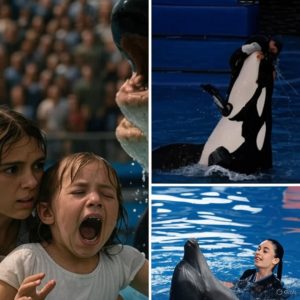A peaceful tide of flowers turned to terror as an orca crashed through Jessica Radcliffe’s seaside memorial, its desperate charge carrying her injured daughter into the stunned crowd. What began as a quiet tribute to the beloved trainer spiraled into chaos, mourners frozen between awe and fear as the wild creature acted with shocking intent. Was this a heartbroken outburst from an animal she once tamed, or a tragic misstep that defied nature’s bounds? Tears mixed with gasps as the scene unfolded, igniting a surge of empathy and unease. Radcliffe’s legacy, once a symbol of harmony with the wild, now hangs under a cloud of unanswered questions. What drove the orca’s bold move, and will it reshape our understanding of animal bonds?
Full story below👇👇
The seaside memorial for Jessica Radcliffe was meant to be a serene farewell—a chance for loved ones, former colleagues, and admirers to celebrate the life of a woman who dedicated herself to building bridges between humans and the wild. The tide carried flowers gently onto the water, each bloom a symbol of remembrance. But what began as a quiet, graceful tribute was torn apart by a moment no one could have predicted.

Without warning, an orca—an animal Radcliffe had once trained—surged through the waters near the shore. In a desperate and forceful charge, it pushed her injured daughter into the gathered crowd. For an instant, time seemed to freeze. Mourners stood in stunned silence, unsure whether to flee in fear or stay rooted in awe. What they had just witnessed was not a random disturbance but an act that seemed charged with intent, almost as if the animal itself were expressing the grief that hung so heavily over the day.
Eyewitnesses described the atmosphere as a collision of terror and heartbreak. Some gasped in fear as the orca thrashed, while others were moved to tears by what they interpreted as a desperate attempt to connect, to say something beyond human language. It was, in every sense, a moment that shattered expectations of what a memorial—and an animal—could be.
The incident has sparked a heated global debate. Was the orca’s bold move an instinctive outburst, a tragic miscalculation of its strength? Or was it, as some believe, an unmistakable display of emotion, a raw expression of grief for a trainer it once knew and trusted? Marine biologists remain divided. Some insist that attributing human-like feelings to wild creatures risks misunderstanding their behavior. Others argue that decades of research suggest animals, particularly orcas, are capable of complex social bonds and even mourning rituals.
Radcliffe herself had always spoken about the deep intelligence of orcas, often describing them as beings of profound sensitivity. For those who admired her work, the orca’s presence at the memorial felt eerily symbolic—a reminder of the fragile, often misunderstood connections she had devoted her life to exploring. Yet for others, the incident was a grim warning about the dangers of human interaction with wild creatures, even in moments of tribute.
The tragedy also raised difficult questions for Radcliffe’s family. Her daughter, though injured, survived the ordeal, but the emotional scars may linger longer than the physical wounds. Witnesses could not ignore the painful symbolism of a wild animal Radcliffe had once worked with colliding so violently with her family during the very event meant to honor her.
Now, Radcliffe’s legacy hangs under a cloud of uncertainty. Once celebrated as a symbol of harmony between people and nature, it has been complicated by a single, shocking act. Yet perhaps this very complexity is what makes her story resonate even more deeply. It forces us to reckon with the truth: that the wild is not easily understood or controlled, and that our bonds with it may be as fragile as they are profound.
In the end, the orca’s desperate charge left more questions than answers. It turned a peaceful memorial into a global conversation about grief, empathy, and the hidden depths of animal emotion. And in doing so, it ensured that Jessica Radcliffe’s story will continue—not as a tale neatly closed, but as an enduring mystery at the edge of human and animal understanding.
Leave a Reply